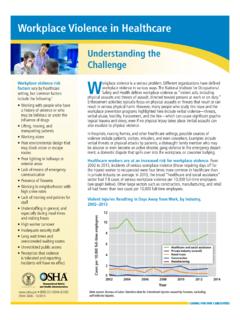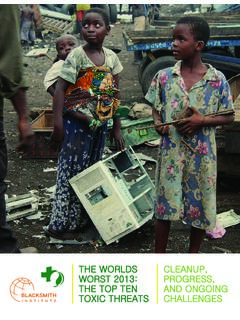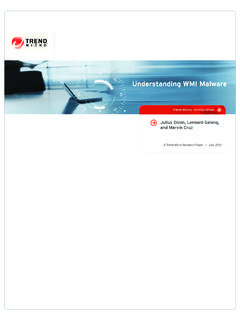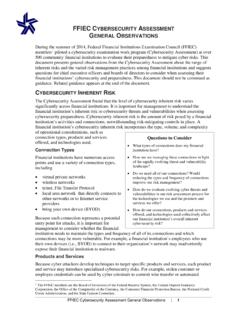Transcription of Security Threats to Saudi - Institute for Gulf Affairs
1 Security Threats to Saudi Arabia s Oil Infrastructure The Institute for Gulf Affairs [i] About the Institute The Institute for Gulf Affairs is an independent, nonpartisan organization that disseminates information about the Gulf region and produces thoughtful analyses of Gulf politics and international relations. Based in Washington, , the Institute is at the center of a global network of reliable individuals, some of whom, due to the closed nature of the Saudi political system, have no other outlet for their views.
2 In order to fulfill this mission, the Institute : Hosts conferences in Washington, where informed analysts debate major issues concerning the Gulf countries and US-Gulf Relations. Conducts independent research and investigations, reports of which are posted on this website: Fosters a deeper understanding of the Gulf countries among Washington policymakers and members of the press corps by providing them with up-to-date and exclusive information, and by putting them in contact with reliable analysts.
3 Sponsor task forces whose reports help define the foreign policy agenda. The Institute for Gulf Affairs 1900 L Street , Suite 309 Washington, DC 20036 Tel (202) 466-9500 [ii] About the Authors Ali Al-Ahmed is the Director of the Institute for Gulf Affairs . He is a Saudi Arabian scholar, lecturer and expert on Saudi political Affairs including: terrorism, Islamic movements, Wahhabi Islam, Saudi political history, Saudi -American relations, and the al-Saud family history. He is a writer, and public speaker on Saudi political issues.
4 He delivered many lectures around the world including at Princeton University, Amnesty International, British House of Lords, French Senate, US Congress, the Hudson Institute and Meridian International Center. As an investigative journalist he exposed major news stories such as the US government botched translation of the 9-11 Bin Laden tape, and the video of Daniel Pearl's murder by Al-Qaeda in Pakistan. A frequent consultant to major world media outlets including CBS News, CNN, PBS, Fox News, Washington Post, and Associated Press, Al-Ahmed has been quoted in the Washington Post, The Wall Street Journal, USA Today, The Boston Globe and other newspapers in several languages.
5 He has authored reports on Saudi Arabia regarding religious freedom, torture, press freedom, and religious curriculums. Andrew Bond is the Assistant Director at the Institute for Gulf Affairs . As the Assistant Director, Andrew supervises the Institutes policy publications as well as co-supervises the Institutes human rights campaigns. He has appeared as a Middle East Expert to various media outlets and has published several articles for the Institute . Andrew holds a Master of Arts in International Relations from Hult International Business School in London, UK and BA in International Studies with a concentration in Islamic Studies from Humboldt State University.
6 Daniel Morillo a Security and Military Policy Analyst at the Gulf Institute . He graduated Cum Laude from Virginia Tech with a Bachelor of Arts in International Studies with a concentration in World Policy and Politics and a focus on terrorism and Security in the Middle East and Africa. He also earned a commission in the United States Air Force as a Second Lieutenant and is a member the United States Air Force Reserve. Additionally, the following provided support to this report: Jessica Ann Koontz (MA 13, The George Washington University); Jared Matthew King (BA 13, The George Washington University); Joshua Jacobs and; Eliot Sackler (BA 15, Columbia University).
7 [iii] Table of Contents ABOUT THE Institute .. I ABOUT THE AUTHORS ..II TABLE OF CONTENTS ..III TABLE OF FIGURES .. V EXECUTIVE SUMMARY .. 1 PREFACE .. 2 OIL INFRASTRUCTURE .. 3 HISTORY OF Saudi ARAMCO .. 3 OIL FIELDS .. 3 OIL STABILIZATION .. 5 REFINERIES .. 6 PIPELINE NETWORK .. 9 TERMINALS .. 11 OIL EXPORTS .. 11 VULNERABILITIES .. 13 CHOKEPOINT VULNERABILITIES .. 13 Strait of Hormuz .. 13 Bab al-Mandab .. 13 PIPELINE NETWORK VULNERABILITIES .. 13 POTENTIAL Threats .. 15 AL-QAEDA .. 15 Saudi HEZBOLLAH (HEZBOLLAH AL-HIJAZ) .. 18 IRANIAN CONVENTIONAL FORCES THREAT.
8 23 Iranian Navy .. 24 Anti-Ship Cruise Missiles .. 26 Iranian Ballistic Missiles .. 30 Iranian Drones .. 34 Saudi DEFENSE & DETERRENCE .. 39 EMERGING Threats : VIGILANTISM, DISCONTENT AND ROYAL INFIGHTING .. 42 Khobar .. 46 Yanbu .. 46 Jubail .. 46 Riyadh .. 47 YEMEN .. 47 IRAQ .. 48 NIGERIA .. 49 HORN OF AFRICA .. 50 ALGERIA .. 51 [iv] LIBYA .. 51 Saudi Security FORCES .. 53 Saudi ARAMCO Security .. 56 Aramco Industrial Security .. 56 MINISTRY OF INTERIOR FORCES .. 56 General Security Service .. 56 Installation Security Force .. 56 Mujahideen.
9 56 The Border and Coast Guard .. 56 Interior Ministry Special Forces .. 57 Road Safety Forces .. 57 General Directorate of Investigations .. 57 MINISTRY OF DEFENSE FORCES .. 57 Navy .. 57 Army .. 57 National Guard Forces .. 57 RECOMMENDATIONS .. 58 FOOTNOTES .. 60 [v] Table of Figures Figure 1 Graph of Leading Saudi Oil Fields and share of national production .. 4 Figure 2: Map of Eastern Province Onshore and Offshore Oil and Natural Gas Fields .. 5 Figure 3: Map of Saudi Arabia indicating Oil Fields and Refinaries.
10 8 Figure 4: Saudi Arabia s daily refining capacity in barrels per day at top Refineries .. 9 Figure 5: Pipeline Network Northeast of Abqaiq Facility .. 10 Figure 6: Iranian Navy Ships .. 25 Figure 7: Comparison of Major Iranian ASCM models .. 27 Figure 8: Estimated Range and Visual of Iranian Long-Range Missiles .. 34 Figure 9: Shahed-129 .. 35 Figure 10: Sarir H-110 .. 36 Figure 11: The new Hamaseh combat-reconnaissance UAV .. 36 Figure 12: Saudi Arabia's Security Apparatus .. 53 Figure 13: Saudi Arabia Royal Family Tree .. 54 [1] Executive Summary Saudi Arabia's oil infrastructure constitutes one of the most important components of the global economy.








